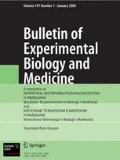Abstract
A new method of enforced continuous dynamic work for rats and mice is suggested. The animal, fixed by its tail in a vertical position above the surface of the water, which it touches only with its snout and forefoot, is compelled to do continuous muscular work. The onset of total fatigue is shown by the cessation of muscular activity, as the result of which the animal drowns. The method is suitable for mass screening of compounds with adaptogenic properties and to study the mechanisms of increasing the endurance and working capacity of animals, and it enables physiological parameters to be recorded in the course of the experiment.
Similar content being viewed by others
Literature Cited
I. I. Brekhman, Ginseng [in Russian], Leningrad (1957).
I. I. Brekhman, Eleuterococcus [in Russian], Leningrad (1968).
N. V. Zimkin et al., Trudy Inst. Fiz. Kul't. Sport im. V. I. Lenina,22, 3 (1959).
M. P. Rylova, Experimental Methods of Investigation of the Chronic Action of Harmful Environmental Factors [in Russian], Moscow (1964).
A. S. Saratikov, Golden Root (Rhodiola rosea) [in Russian], Tomsk (1974).
B. Bhagat and N. Wheeler, Neuropharmacology,12, 1161 (1973).
C. A. Dawson, Med. Sci. Sports,2, 51 (1970).
R. M. Glaser, P. M. Gross, and H. S. Weiss, Proc. Soc. Exp. Biol. (New York),40, 230 (1972).
Rights and permissions
About this article
Cite this article
Avakyan, O.M., Shirinyan, É.A. New model of dynamic work for small laboratory animals. Bull Exp Biol Med 84, 1366–1368 (1977). https://doi.org/10.1007/BF00805909
Received:
Issue Date:
DOI: https://doi.org/10.1007/BF00805909




